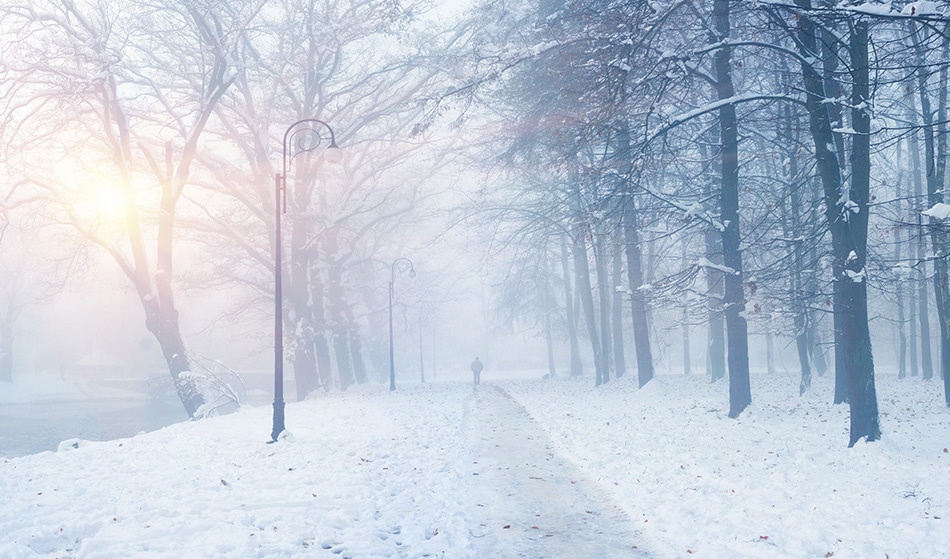-2.jpg) By Thomas HornigoldFeb 28 2018
By Thomas HornigoldFeb 28 2018It’s unlikely to have escaped your attention that the weather has been a little strange recently. Much of Europe has been covered in snow and battling freezing temperatures. Britain has been spared the worst of the cold front, with temperatures only dropping to a low of -8.9C. Temperatures throughout the rest of Europe on the other hand, have dipped as low as –30C during this cold spell. Heavy snow, especially in the North of England, has led to widespread school closures and transport disruption, and the cold snap is expected to continue in some places until the end of the week.
 Image credit: Roman Mikhailiuk/Shutterstock
Image credit: Roman Mikhailiuk/Shutterstock
There has also been unusual weather in another region of the world - the northern-most weather station at the tip of Greenland is experiencing an unusually mild winter. At times, the temperature has reached above freezing over the North Pole, whereas residents of various European cities have described having to commute in “sub-Arctic conditions.” Just as some places in Italy and Europe were tens of degrees below their normal temperature for the time of year, this was mirrored by anomalously warm temperatures in Arctic regions. So are the events related – and, the ultimate question – is it linked to climate change?
Attribution of any particular weather phenomenon is tricky. There are many simultaneously occurring processes, interlinked in ways that are complex and not entirely understood. In this sense, scientists are cautious about attributing any one weather event to a single proximate cause. In the case of the 'Beast from the East,' a “sudden stratospheric warming” event has been implicated.
How Does it Happen?
Jet streams are patterns of air circulation that occur high up in the atmosphere, in both the Northern and Southern hemisphere. A visualization tool allowing you to see directions and patterns of the wind at various altitudes can be found here. Set the height to well above the Earth's surface, and you’ll be able to see jet-streams encircling the North and South poles. You might even notice that the jet stream in the North is behaving differently.
A sudden stratospheric warming (SSW) event begins with a large amount of cold air above the North Pole that is suddenly compressed. Natural weather patterns or disturbances lower down in the atmosphere can sometimes disrupt this westerly flow.
This causes the Polar Jet to wobble and these wobbles, or waves, break just like waves on the beach. When they break, they can be strong enough to weaken or even reverse the westerly winds and swing them to easterlies. As this happens, air in the stratosphere starts to collapse into the polar cap and compress. As it compresses it warms, hence the stratospheric warming.
According to the Met Office:
Sudden Stratospheric Warming in Britain
Britain is mild for its latitude, thanks mostly to warm air that arrives from the Gulf Stream. When SSW events result in these easterly winds and jet stream disruption, our jet stream shifts South. High pressure over the North Atlantic then temporarily “blocks” the Gulf Stream and cold air is dragged in from the continent over the East. The cold air builds up over Britain in a “polar vortex,” and then sinks to ground level, leading to the Siberian conditions (at least by British standards.)
These SSW events are not uncommon, occurring roughly six times per decade in the Northern hemisphere. When they impact our weather on the surface, it tends to lead to anomalously high temperatures over Greenland and anomalously low temperatures over Europe and the Eastern US. But are they linked to climate change?
It’s not yet clear. The standard approach to attributing extreme weather events is to run large collections of climate models, both with and without human influences. You can then get an assessment of how much more likely the event is in a world with anthropogenic climate change: if it occurs in five times as many human-influenced models as models with natural drivers, you have evidence to suggest it’s five times more likely.
There is a hypothesis that declining Arctic sea ice may be responsible for making these SSW and blocking events more common, and hence leading to a higher number of cold snaps. Due to a phenomenon called Arctic amplification, the impacts of climate change will be greatest in the Arctic – which can warm by 2-3 degrees for every degree of global mean temperature change. Given this, a great deal of literature has focused on the potential for destabilization of the polar jet stream as the temperature contrast between the Arctic and the rest of the Northern hemisphere reduces. Patterns of circulation that are today unusual could become more common.
Ultimately, it’s too soon in this unprecedented climate to say with any confidence whether a particular event is within the bounds of natural variability, or whether these events are becoming more common or less intense. On the whole, scientists believe that cold snaps should get less extreme in the coming years and decades. However, this will be of little comfort to anyone this week who has to walk to work and forgets their gloves
Disclaimer: The views expressed here are those of the author expressed in their private capacity and do not necessarily represent the views of AZoM.com Limited T/A AZoNetwork the owner and operator of this website. This disclaimer forms part of the Terms and conditions of use of this website.